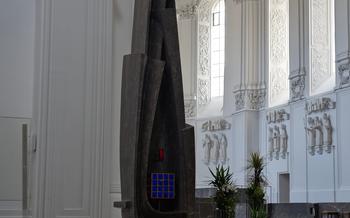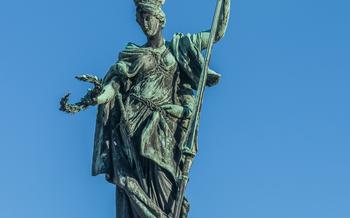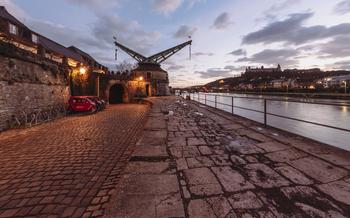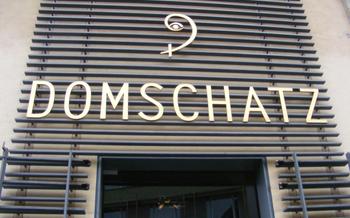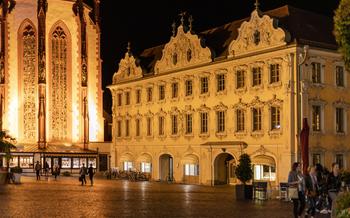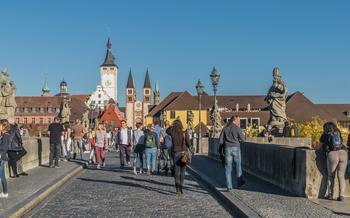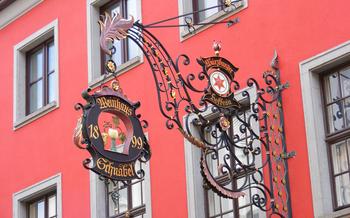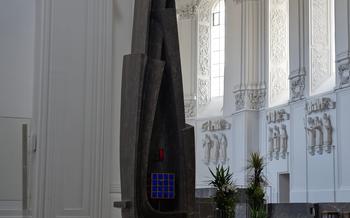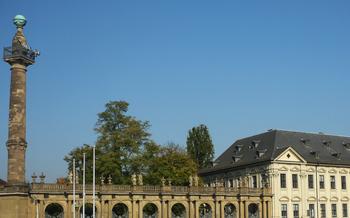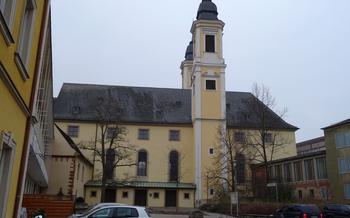
Röntgen Memorial Site
- The Röntgen Memorial Site: A Journey into the Life of a Pioneer
- Step Back in Time: Röntgen's Laboratory
- The X-Ray Revolution: Changing the World of Medicine
- From Würzburg to the World: Röntgen's Legacy
- Interactive Exhibits: Engaging with Röntgen's Discoveries
- Guided Tours: Unraveling Röntgen's Story
- Educational Programs: Inspiring the Next Generation
- The Röntgen Prize: Honoring Excellence in Physics
- Temporary Exhibitions: Exploring New Frontiers
- The Würzburg Residence: A UNESCO World Heritage Site
- The Main Bridge: A Symbol of Würzburg's History
- The Würzburg Cathedral: A Gothic Masterpiece
- The Käppelestadt: A Charming Neighborhood by the River
- Insider Tip: Local Delicacies
The Röntgen Memorial Site: A Journey into the Life of a Pioneer
Wilhelm Röntgen, a German physicist, made one of the most significant discoveries in the field of science when he stumbled upon X-rays in 189His groundbreaking work not only revolutionized the medical field but also opened up new avenues of exploration in physics.
The Röntgen Memorial Site, located in Würzburg, Germany, offers visitors a unique opportunity to delve into the life and achievements of this scientific pioneer. Situated in the heart of the city, the memorial site encompasses Röntgen's original laboratory, a museum, and an archive, providing a comprehensive exploration of his revolutionary discovery.
Entering the memorial site, visitors are transported back in time to Röntgen's era. The original laboratory, meticulously preserved, allows visitors to witness the humble beginnings of X-ray technology. Artifacts, such as the original X-ray tube and photographic plates, offer a tangible connection to Röntgen's groundbreaking experiments.
The museum, housed in a modern building adjacent to the laboratory, takes visitors on a chronological journey through Röntgen's life and work. Interactive exhibits, multimedia presentations, and historical documents provide insights into his scientific endeavors, his collaborations with other scientists, and the impact of his discovery on the world.
Step Back in Time: Röntgen's Laboratory
Step into the original laboratory where Wilhelm Röntgen made his groundbreaking discoveries and revolutionized the world of medicine. Explore this meticulously preserved space, which has been transformed into a museum that allows visitors to immerse themselves in the atmosphere of a 19th-century physics laboratory.
See the very equipment and artifacts that Röntgen used to conduct his experiments, including the X-ray tube that produced the first-ever X-ray image. Learn about the painstaking process of experimentation that led to Röntgen's discovery, and witness the evolution of X-ray technology from its rudimentary beginnings to its modern applications.
Experience the thrill of scientific discovery as you follow in Röntgen's footsteps, retracing his journey from curiosity to groundbreaking achievement. Immerse yourself in the world of physics and innovation as you explore this fascinating laboratory, where the seeds of a medical revolution were sown.
The X-Ray Revolution: Changing the World of Medicine
Wilhelm Röntgen's discovery of X-rays in 1895 revolutionized the field of medicine. Prior to this groundbreaking achievement, doctors had limited tools for diagnosing and treating internal injuries and diseases. Röntgen's discovery allowed physicians to see inside the human body without surgery, leading to a new era of medical diagnosis and treatment.
The impact of X-rays on medicine was immediate and profound. Within months of Röntgen's discovery, X-ray machines were being used in hospitals around the world. Doctors were able to diagnose fractures, locate foreign objects, and detect tumors and other abnormalities that were previously invisible. X-rays also proved to be a valuable tool for monitoring the progress of medical treatments, such as bone healing and the effectiveness of radiation therapy for cancer.
The development of X-ray technology has continued to evolve over the years, leading to new and innovative applications in medicine. Today, X-rays are used in a wide range of medical fields, including radiology, dentistry, orthopedics, and cardiology. They are also essential for medical imaging techniques such as CT scans, MRI scans, and fluoroscopy.
The discovery of X-rays not only revolutionized the practice of medicine but also had a profound impact on society as a whole. It led to the development of new medical specialties, such as radiology, and the establishment of X-ray departments in hospitals and clinics worldwide. Röntgen's discovery also had a significant impact on public health, as it enabled the early detection and treatment of diseases that were previously difficult or impossible to diagnose.
From Würzburg to the World: Röntgen's Legacy
Wilhelm Röntgen's discovery of X-rays not only revolutionized the field of medicine but also had a profound impact on science and technology worldwide. His groundbreaking work in Würzburg propelled him to international recognition, and he soon became a sought-after collaborator and mentor to scientists around the globe.
Röntgen's legacy extended far beyond his initial discovery. He inspired a generation of physicists to pursue research in the field of X-rays and radiation, leading to numerous advancements in medical imaging, radiation therapy, and other applications. His work laid the foundation for modern radiology, which has become an indispensable tool in diagnosing and treating diseases.
The impact of Röntgen's discovery was not limited to the scientific community. It also had a significant societal impact, as X-rays became widely adopted in various fields, including industry, security, and archaeology. Röntgen's work opened up new possibilities for examining the internal structure of objects, leading to advancements in manufacturing, quality control, and non-destructive testing.
Röntgen's legacy continues to shape the world of science and technology today. His pioneering spirit and dedication to scientific research have inspired countless scientists and innovators to push the boundaries of knowledge and make groundbreaking discoveries. The Röntgen Prize, established in his honor, recognizes outstanding achievements in physics and serves as a testament to his enduring influence on the field.
Röntgen's discovery of X-rays not only revolutionized medicine but also left an indelible mark on the world of science and technology, inspiring generations of researchers and shaping the modern world in countless ways.
Interactive Exhibits: Engaging with Röntgen's Discoveries
The Röntgen Memorial Site offers a range of interactive exhibits that bring Röntgen's discoveries to life and make learning about X-rays and physics fun and engaging. Visitors can get hands-on with experiments that replicate Röntgen's original setup, demonstrating how he produced the first X-ray images. Interactive displays explain the science behind X-rays in a clear and accessible way, using animations, diagrams, and multimedia presentations. Virtual reality simulations transport visitors back in time to Röntgen's laboratory, allowing them to experience the atmosphere of a 19th-century physics laboratory and witness Röntgen's groundbreaking experiments firsthand. Interactive quizzes and games challenge visitors to test their knowledge of X-rays and physics, making learning an enjoyable and interactive experience.
Guided Tours: Unraveling Röntgen's Story
To fully immerse yourself in the life and work of Wilhelm Röntgen, join one of the guided tours offered at the Röntgen Memorial Site. Led by knowledgeable experts, these tours provide an in-depth exploration of Röntgen's laboratory, his experiments, and the impact of his discoveries.
Expert guides will take you on a journey through time, delving into the details of Röntgen's groundbreaking research and its significance to the field of medicine and beyond. Ask questions, engage in discussions, and gain insights into the mind of a scientific pioneer who changed the course of history.
With a guided tour, you'll gain a deeper understanding of Röntgen's contributions to science and the legacy he left behind. It's an opportunity to unravel the story of a remarkable individual whose work continues to shape the world of medicine and technology.
Educational Programs: Inspiring the Next Generation
The Röntgen Memorial Site is committed to inspiring the next generation of scientists and researchers. It offers a range of educational programs designed to engage students of all ages with the wonders of science and the legacy of Wilhelm Röntgen.
Schools and groups can book guided tours that cater to different age levels and curriculum requirements. These tours provide an interactive and immersive experience, allowing students to explore Röntgen's laboratory, learn about his groundbreaking discoveries, and conduct hands-on experiments related to X-rays and physics.
The memorial site also hosts workshops, lectures, and science fairs throughout the year. These events offer students the opportunity to interact with scientists, engage in hands-on activities, and learn about the latest advancements in physics and related fields.
For aspiring young scientists, the Röntgen Memorial Site provides a unique platform to foster their passion for science and discovery. Through its educational programs, the memorial site aims to inspire the next generation of innovators and problem-solvers who will shape the future of science and technology.
The Röntgen Prize: Honoring Excellence in Physics
The Röntgen Prize is a prestigious award presented annually by the Institute of Physics, University of Würzburg, to honor outstanding achievements in the field of physics. Established in 1995, the prize recognizes scientists who have made significant contributions to the advancement of physics, particularly in the areas of experimental or theoretical research related to X-rays and their applications.
The selection process for the Röntgen Prize is rigorous and competitive. A distinguished jury, composed of renowned physicists from around the world, evaluates nominations and selects the recipient based on the impact and originality of their research, as well as their contributions to the advancement of knowledge in physics.
Past recipients of the Röntgen Prize include eminent scientists such as Giorgio Parisi, a Nobel laureate in physics, and Donna Strickland, a Nobel laureate in physics. These distinguished individuals have made groundbreaking discoveries and pushed the boundaries of our understanding of the physical world.
The Röntgen Prize ceremony is a significant event in the scientific community, bringing together leading physicists from across the globe. The award presentation is accompanied by a scientific symposium, where the recipient shares their research findings and engages in discussions with fellow scientists.
By honoring exceptional physicists, the Röntgen Prize not only celebrates their achievements but also inspires the next generation of scientists to pursue excellence and innovation in the field of physics. It serves as a testament to the enduring legacy of Wilhelm Röntgen and his groundbreaking discovery of X-rays, which continues to shape our understanding of the world around us.
Temporary Exhibitions: Exploring New Frontiers
The Röntgen Memorial Site stays current with temporary exhibitions that showcase cutting-edge research and developments in physics. These exhibitions provide a platform for contemporary issues related to X-rays and their applications. Visitors can engage with the latest advancements in medical imaging, radiation therapy, and other fields, broadening their knowledge of the ever-evolving realm of physics.
Temporary exhibitions offer a dynamic and interactive experience, complementing the permanent displays at the memorial site. They allow visitors to explore the most recent discoveries and innovations in physics, fostering a sense of wonder and curiosity. Whether it's learning about the latest medical imaging techniques or delving into the mysteries of the universe, these exhibitions provide a glimpse into the future of scientific exploration.
The Würzburg Residence: A UNESCO World Heritage Site
Standing majestically in the heart of Würzburg, the Würzburg Residence is a testament to the city's rich history and architectural splendor. This magnificent palace, with its sprawling complex of buildings, lush gardens, and impressive collection of art and artifacts, is a UNESCO World Heritage Site and a must-visit for anyone exploring Würzburg.
The residence was built in the 18th century by the prince-bishops of Würzburg as their opulent home and seat of power. Its construction spanned several decades, resulting in a harmonious blend of Baroque and Rococo architectural styles. The palace's grand facade, adorned with intricate carvings, statues, and a sweeping staircase, hints at the lavishness that awaits within.
Inside, visitors are greeted by a series of opulent state rooms, each more impressive than the last. The White Hall, with its gleaming white walls, intricate stucco work, and sparkling chandeliers, is a breathtaking example of Baroque grandeur. The Emperor's Hall, used for ceremonial occasions, boasts a stunning ceiling fresco depicting the glorification of the Holy Roman Emperor.
The residence also houses an extensive art collection, showcasing works by renowned masters such as Tiepolo, Canaletto, and Rubens. Visitors can admire paintings, sculptures, tapestries, and furniture that reflect the refined taste and artistic patronage of the prince-bishops.
Beyond the palace's grand interiors, the Hofgarten (Court Garden) invites visitors to explore its serene beauty. Laid out in the French formal style, the garden features meticulously manicured lawns, colorful flower beds, and graceful fountains. The Orangery, with its collection of exotic plants, adds a touch of tropical elegance to the garden's tranquil atmosphere.
A visit to the Würzburg Residence is a journey through time, allowing visitors to immerse themselves in the grandeur and opulence of a bygone era. Whether admiring the architectural masterpieces, exploring the art collection, or strolling through the serene gardens, the Würzburg Residence offers a truly unforgettable experience.
The Main Bridge: A Symbol of Würzburg's History
Strolling across the Main Bridge, one of Würzburg's most iconic landmarks, is a must-do experience for any visitor. This picturesque bridge spans the Main River, connecting the city center with the district of Heidingsfeld. Its construction, completed in 1888, marked a significant milestone in Würzburg's history, replacing an older wooden bridge that had stood for centuries.
As you walk across the bridge, take a moment to admire its intricate design. The bridge features 12 sandstone statues, each representing a different historical figure or allegorical figure associated with Würzburg. These statues, crafted by renowned sculptors of the time, add a touch of grandeur and historical significance to the bridge.
From the bridge, you'll be treated to panoramic views of Würzburg's cityscape. On one side, you'll see the imposing silhouette of the Würzburg Residence, with its magnificent gardens and ornate facades. On the other side, you'll have a clear view of the Marienberg Fortress, perched high on a hill, overlooking the city.
The Main Bridge is not just a passageway; it's a place where locals and visitors alike gather to relax, socialize, and take in the beauty of their surroundings. On warm summer evenings, the bridge becomes a popular spot for strolling couples, joggers, and cyclists. During special events and festivals, the bridge is often decorated with colorful lights and decorations, creating a magical atmosphere.
Whether you're a history buff, a nature lover, or simply someone who appreciates beautiful architecture, crossing the Main Bridge is an experience that should not be missed when visiting Würzburg. Remember to bring your camera to capture the stunning views and the bridge's intricate details.
The Würzburg Cathedral: A Gothic Masterpiece
In the heart of Würzburg, nestled amidst the city's vibrant streets, stands the Würzburg Cathedral, an awe-inspiring testament to Gothic architecture. This majestic edifice, with its soaring spires and intricate ornamentation, has stood as a symbol of faith and artistry for centuries.
As you approach the cathedral, its imposing façade captivates the eye. The intricate carvings adorning the portals depict biblical scenes and figures, inviting visitors to delve into the rich history and spirituality that lie within. Step inside, and you'll be greeted by a breathtaking expanse of vaulted ceilings, supported by graceful columns that create a sense of awe and wonder.
The cathedral's interior is a treasure trove of artistic masterpieces. Stained glass windows bathe the space in a kaleidoscope of colors, casting a warm glow on the elaborate frescoes and sculptures that adorn the walls. Each detail, from the intricate carvings of the choir stalls to the delicate tracery of the windows, showcases the exceptional craftsmanship of medieval artisans.
Take the time to explore the cathedral's many chapels, each dedicated to a different saint or purpose. In the Marienkapelle, marvel at the exquisite Pietà, a poignant depiction of the Virgin Mary cradling the body of Christ. The Neumünsterkapelle, with its stunning Renaissance altar, offers a glimpse into the cathedral's rich history.
Whether you're a history buff, an architecture enthusiast, or simply seeking spiritual inspiration, the Würzburg Cathedral is a must-visit destination. Immerse yourself in its sacred atmosphere, admire its architectural wonders, and experience the enduring legacy of faith and artistry that this Gothic masterpiece represents.
The Käppelestadt: A Charming Neighborhood by the River
Stroll along the cobblestone streets of the Käppelestadt, a picturesque neighborhood nestled along the banks of the Main River. Admire the colorful facades of the half-timbered houses, each with its own unique charm. Explore the narrow alleys and discover hidden courtyards, where time seems to stand still.
Visit the Alte Mainbrücke, the oldest bridge in Würzburg, and marvel at its intricate stonework and statues. From the bridge, enjoy breathtaking views of the river, the city skyline, and the surrounding hills.
Immerse yourself in the vibrant atmosphere of the Käppelestadt, with its lively cafés, traditional restaurants, and acogedor bars. Savor the flavors of Franconian cuisine, indulge in local wines and beers, and experience the warm hospitality of the locals.
Whether you're looking to shop for souvenirs, admire historical landmarks, or simply soak up the charm of this enchanting neighborhood, the Käppelestadt is a must-visit for any traveler to Würzburg.
Insider Tip: Local Delicacies
Würzburg is a haven for food enthusiasts, offering a delectable array of local specialties that will tantalize your taste buds. Indulge in the hearty flavors of Schäufele, a succulent roast pork shoulder slow-cooked to perfection. Sample the iconic Bratwürste, grilled sausages that are a staple of Franconian cuisine. For a sweet treat, try Zwetschgendatschi, a traditional plum cake that bursts with fruity goodness.
To fully immerse yourself in the local culinary scene, visit the weekly farmers' market, where you can purchase fresh produce, artisanal cheeses, and other regional delicacies. Be sure to sample a glass of Franconian wine or beer, produced in the region's vineyards and breweries, to complete your culinary journey through Würzburg.
